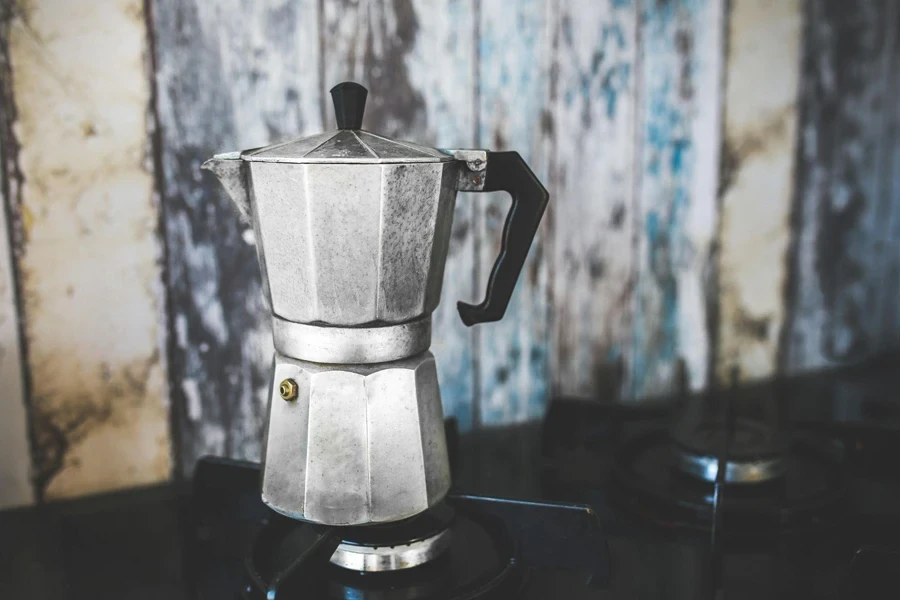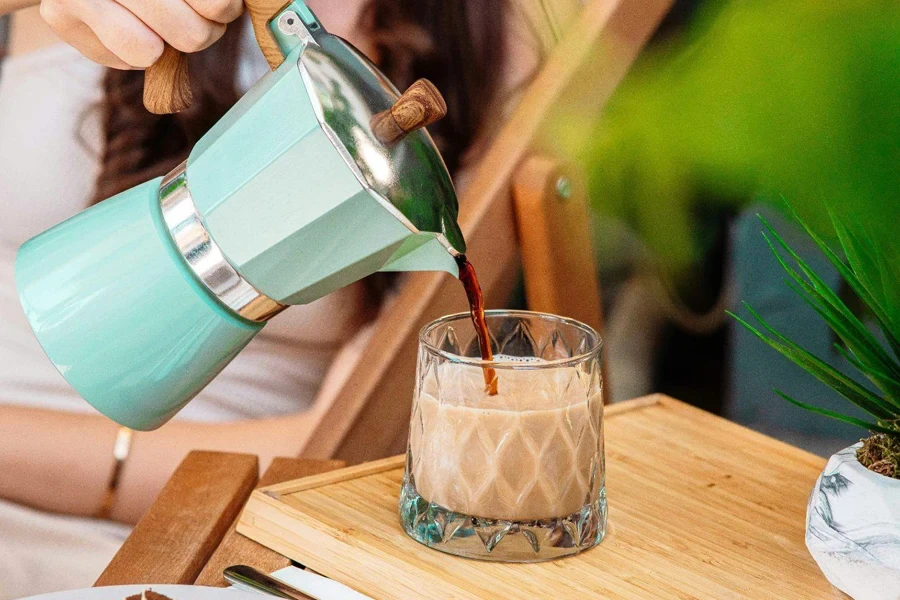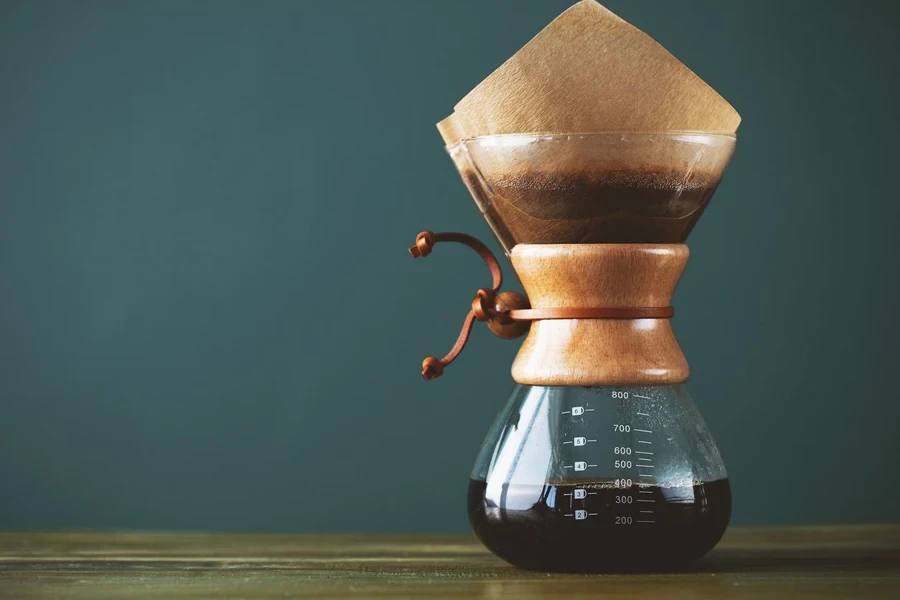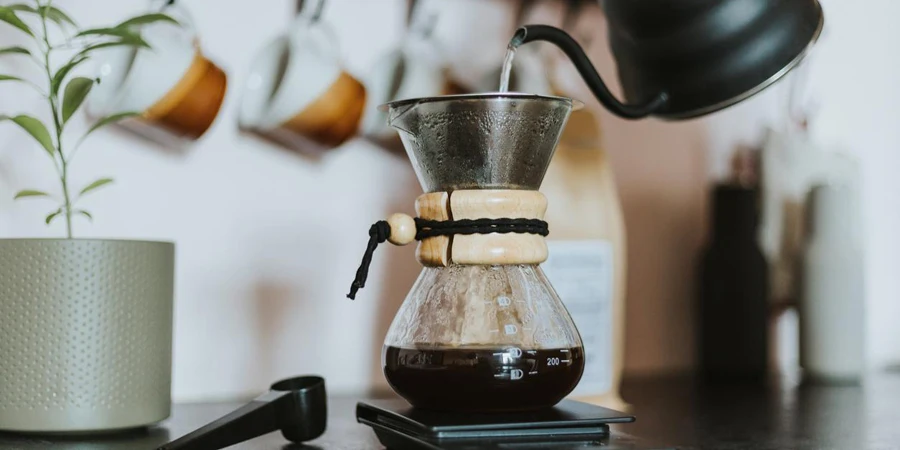Once a staple in mid-century kitchens, the percolator is experiencing a significant revival among modern coffee enthusiasts. This brewing method combines robust flavor and ritual, appealing to those seeking a traditional coffee experience. Its simplicity and efficiency, now enhanced by modern technology, meet the exacting standards of today’s coffee culture. The resurgence of percolators underscores a broader appreciation for artisanal methods, making them a noteworthy consideration for any entity focused on delivering exceptional coffee experiences.
Table of Contents
1. Decoding percolator varieties
2. Current trends shaping percolator markets
3. Selecting the ideal percolator: a buyer’s guide
4. Showcase of 2024’s premier percolators
Decoding percolator varieties

Electric vs. stovetop percolators: understanding the mechanics. The distinction between electric and stovetop percolators lies in their heat sources and the overall brewing mechanics, pivotal for determining their suitability for different environments. Electric percolators come with a built-in heating element, allowing for automated control over the brewing temperature and cycle. This automation ensures a consistent quality of brew by maintaining optimal brewing conditions without manual intervention, ideal for environments where convenience and consistency are paramount. On the other hand, stovetop percolators require an external heat source such as a stove or campfire, offering a more hands-on brewing experience. This method is often celebrated for its traditional approach to coffee making, appealing to purists who favor manual control over every aspect of the brewing process.
Stovetop models are particularly noted for their durability and simplicity, often made from robust materials like stainless steel or aluminum, which are also easy to transport and use in outdoor settings. However, the process is more labor-intensive, relying on the user to manage the heat source to prevent the coffee from overheating and becoming bitter due to prolonged exposure to high temperatures. The result is a brew that can vary greatly in strength and flavor, reflecting the skill and attentiveness of the person brewing it.
Navigating the best fit: Where to use which percolator? Choosing between an electric and a stovetop percolator often comes down to the intended usage environment and the desired level of involvement in the brewing process. Electric percolators are best suited for office settings or homes where the demand for coffee is high and the preference for convenience over ritual is pronounced. Their ability to brew large quantities of coffee at consistent temperatures makes them a staple in such environments.
Conversely, stovetop percolators shine in settings where brewing coffee is viewed as a more immersive, hands-on experience. This can include outdoor activities like camping or in households where the coffee-making process is a cherished start to the day. The adaptability of stovetop models to various heat sources also makes them invaluable for use in areas without reliable electricity, ensuring that a good cup of coffee is never out of reach, regardless of the setting.
The resurgence of percolators in the coffee scene speaks to a broader trend towards valuing both the artisanal quality of the brew and the ritual of its preparation. Whether through the push-button convenience of an electric percolator or the tactile engagement of a stovetop model, both varieties offer distinct pathways to achieving a deeply satisfying coffee experience, tailored to the modern connoisseur’s lifestyle and taste.
Current trends shaping percolator markets

Analyzing percolator sales dynamics: Experts currently value the global coffee percolator market at approximately USD 997 million as of 2022. They project it to reach around USD 1.37 billion by 2028, anticipating this growth to occur at a compound annual growth rate (CAGR) of about 5.5% from 2023 to 2028. This forecast underscores a robust demand and expanding market presence for coffee percolators worldwide, fueled by increasing consumer appreciation for traditional brewing methods and a rising trend in global coffee consumption.Recent market analyses reveal significant shifts in percolator sales, reflecting evolving consumer preferences and a growing appreciation for traditional brewing methods. The resurgence in percolator popularity is largely driven by a trend towards artisanal or heritage methods of coffee brewing, which are perceived as offering a superior taste experience compared to modern automatic machines. Data indicates a steady increase in both electric and stovetop percolator sales, with particular interest noted in markets where consumers are looking to replicate a barista-style coffee experience at home.
This trend is further supported by the broader movement towards sustainable consumption. Percolators, especially stovetop models, are often viewed as more environmentally friendly due to their manual operation that does not require electricity and the absence of plastic waste associated with pod coffee machines. Moreover, the durability and long lifespan of most percolator designs appeal to the eco-conscious consumer who prioritizes products that offer sustainability alongside quality.
The global coffee wave and its impact on percolator popularity: The global increase in coffee consumption has had a palpable impact on the percolator market. As coffee culture continues to expand worldwide, there is a growing segment of consumers who are not only interested in high-quality coffee but are also keen to explore different preparation methods that enhance the coffee experience. This has led to a greater demand for percolators, which are celebrated for their ability to brew a distinctly robust and flavorful cup of coffee.
Regions experiencing rapid growth in coffee consumption, such as Asia-Pacific and Latin America, have seen a marked increase in the sales of percolators. In these markets, consumers are shifting away from instant coffee and embracing more sophisticated brewing techniques, including percolation, which is often associated with a more refined taste profile. This shift is supported by rising income levels and greater exposure to global coffee trends through social media and travel.
Moreover, the commercial sector, including cafes and restaurants, is also recognizing the value of percolators as a means to differentiate their offerings. The visual appeal of percolators, particularly elaborate stovetop models, adds to the allure, making the coffee brewing process part of the consumer experience and drawing in customers looking for authenticity and a tactile connection to their food and drink choices.
Selecting the ideal percolator: a buyer’s guide

Capacity and construction: The cornerstones of percolator selection. When assessing percolators, capacity and construction emerge as pivotal factors. Capacity is particularly critical as it dictates how much coffee can be brewed at once. For instance, smaller percolators might have a 4-cup capacity, suitable for individual users or small groups, whereas larger models may offer up to 12 cups, ideal for office settings or large gatherings. The choice should align with anticipated usage to avoid the inconvenience of multiple brewing sessions or excess waste.
Construction quality significantly influences both the durability and the quality of the coffee produced. Stainless steel is a popular choice for percolators due to its durability and its inert nature, which ensures it doesn’t impart flavors to the coffee. Premium models often feature reinforced, heat-resistant handles and spill-proof lids, enhancing safety and usability. For instance, the Presto Stainless-Steel Coffee Percolator, notable for its robust construction, ensures that hot water never contacts plastic, preserving the coffee’s pure flavor.
Maintenance and durability factors: Maintenance simplicity and durability are crucial for long-term satisfaction with a percolator. Models designed for ease of use typically feature simple disassembly processes, making regular cleaning less tedious and helping prevent mechanical failures. For example, some percolators come with dishwasher-safe parts, significantly simplifying the cleaning process. However, it’s essential to check whether specific components like the filter basket and the main body are suitable for dishwasher cleaning or require hand washing.
The material of the percolator not only affects its lifespan but also how it withstands daily use. Stainless steel and aluminum are favored for their strength and heat conductivity, ensuring efficient heating and durability. For example, the Farberware Classic Stainless Steel Yosemite Coffee Percolator is celebrated for its seamless, heavy-duty construction that can handle daily use without compromising on performance or aesthetic appeal.
Moreover, the integration of features such as automatic temperature control and dry boil protection can extend the lifespan of electric percolators by preventing overheating and potential damage. The durability of a percolator often correlates with its warranty period, with longer warranties suggesting higher quality and durability.
Showcase of 2024’s premier percolators

Spotlight on industry leaders and their newest models: In the realm of coffee brewing, percolators have seen a resurgence, albeit with modern twists that aim to mitigate traditional drawbacks. The Presto Electric Percolator stands out in this category, celebrated for its extended brewing cycle that allows for a stronger coffee, much closer to what one might expect from a conventional drip brewer. Its design—a blend of retro and modern aesthetics—also garners attention, making it not just a functional piece of equipment but a conversation starter.
Moreover, leaders in the market like Hamilton Beach and Cuisinart have introduced models that emphasize quicker brewing times, although this sometimes results in a trade-off with flavor quality. These brands continually strive to balance efficiency with taste, pushing the boundaries of what a percolator can achieve.
Comparative review of breakthrough features: When evaluating percolators, several features stand out that set the top models apart from their predecessors. Notably, the design flaws common in older percolators—such as uneven water distribution and prolonged exposure to heat—have been addressed in newer models. For instance, the Presto model incorporates an advanced filtration system that minimizes the recirculation of brewed coffee, a common issue that leads to bitterness. This model’s ability to maintain optimal brewing temperatures throughout the cycle also marks a significant improvement over traditional percolators, which often brew at too high a temperature, extracting unwanted flavors.
Stovetop models, like the Eurolux Percolator, have been redesigned to enhance user control and convenience. These units now feature clearer marking and more robust construction to withstand varied heating sources, making them ideal for settings beyond the kitchen, such as camping. Despite these advancements, the challenge remains in perfecting brew strength and consistency, as these models still tend to produce weaker coffee compared to electric ones.
In terms of cleaning and maintenance, newer percolators have simplified the process. Features such as detachable parts and dishwasher-safe components make them easier to manage and maintain, which is a crucial consideration for frequent users.
Conclusion
Selecting the ideal coffee percolator involves a thorough understanding of various factors such as capacity, construction, maintenance, and the specific brewing needs of different environments. Whether it is the robust flavor offered by models like the Presto 02811, the quick brewing efficiency of the Hamilton Beach 40614, or the rugged versatility of the Farberware 50124 ideal for outdoor use, each model presents unique attributes. Making an informed choice enhances the overall coffee experience, ensuring that each cup meets the expectations of quality and taste demanded by today’s sophisticated coffee drinkers.




